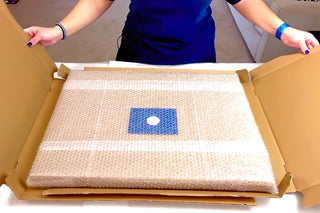Hecuba with the bodies of her children Polyxena and Polydorus at Achilles' tomb - Karl Russ | Art print


View from behind

Frame (optional)
Hecabe with the bodies of her children Polyxena and Polydorus at the tomb of Achilles: a poignant tragedy.
This artwork depicts a scene filled with pain and despair, where Hecabe, an iconic figure of Greek mythology, stands above the bodies of her children, Polyxena and Polydorus. The dark colors and shadows enhance the tragic atmosphere, while the meticulous details of the faces and drapery reveal the artist's technical mastery. The contrast between light and darkness symbolizes the struggle between life and death, immersing the viewer in a moment of deep emotion. This art print of Hecabe with the bodies of her children Polyxena and Polydorus at the tomb of Achilles invites reflection on grief and loss.
Hecabe with the corpses of her children Polyxena and Polydorus at the tomb of Achilles: a tragic legacy.
The artist of this work, whose name is often associated with the Neoclassical period, draws inspiration from mythological stories to explore universal themes such as suffering and sacrifice. This piece, created at a time when art sought to capture human emotion, bears witness to the influence of great masters of the past. Artists of this period often aimed to elevate tragic subjects through refined technique and balanced composition. This art print is a perfect illustration of that pursuit, paying homage to Hecabe’s pain and the tragedy of war.
A decorative acquisition with multiple advantages.
This art print of Hecabe with the bodies of her children Polyxena and Polydorus at the tomb of Achilles is an ideal choice to enhance your interior, whether in a living room, office, or bedroom. Its print quality and fidelity to the original details make it a captivating piece of art that draws attention and sparks conversations. By incorporating this work into your decor, you add a touch of history and emotion, while benefiting from undeniable aesthetic appeal. This art print is not only a piece of art but also a symbol of resilience in the face of adversity.

Matte finish

View from behind

Frame (optional)
Hecabe with the bodies of her children Polyxena and Polydorus at the tomb of Achilles: a poignant tragedy.
This artwork depicts a scene filled with pain and despair, where Hecabe, an iconic figure of Greek mythology, stands above the bodies of her children, Polyxena and Polydorus. The dark colors and shadows enhance the tragic atmosphere, while the meticulous details of the faces and drapery reveal the artist's technical mastery. The contrast between light and darkness symbolizes the struggle between life and death, immersing the viewer in a moment of deep emotion. This art print of Hecabe with the bodies of her children Polyxena and Polydorus at the tomb of Achilles invites reflection on grief and loss.
Hecabe with the corpses of her children Polyxena and Polydorus at the tomb of Achilles: a tragic legacy.
The artist of this work, whose name is often associated with the Neoclassical period, draws inspiration from mythological stories to explore universal themes such as suffering and sacrifice. This piece, created at a time when art sought to capture human emotion, bears witness to the influence of great masters of the past. Artists of this period often aimed to elevate tragic subjects through refined technique and balanced composition. This art print is a perfect illustration of that pursuit, paying homage to Hecabe’s pain and the tragedy of war.
A decorative acquisition with multiple advantages.
This art print of Hecabe with the bodies of her children Polyxena and Polydorus at the tomb of Achilles is an ideal choice to enhance your interior, whether in a living room, office, or bedroom. Its print quality and fidelity to the original details make it a captivating piece of art that draws attention and sparks conversations. By incorporating this work into your decor, you add a touch of history and emotion, while benefiting from undeniable aesthetic appeal. This art print is not only a piece of art but also a symbol of resilience in the face of adversity.






